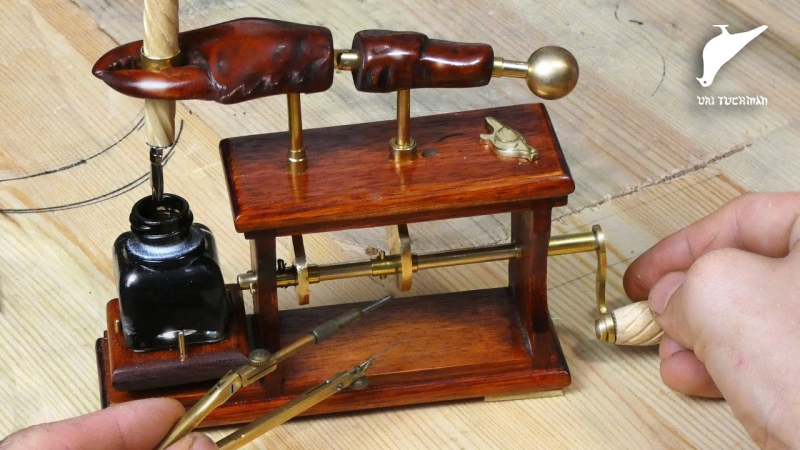[Uri Tuchman] doesn’t always write with a dip pen. But when he does, he gets tired of re-inking it almost immediately. Now, convenience comes in many forms. He could make the switch to any number of modern writing instruments, sure. But that would be throwing out the baby with the bathwater.
[Uri] decided that old-timey problems call for old-timey solutions, and we couldn’t agree more. His machine is an amazingly well-crafted automaton that dips a handmade pen into ink and shakes off the excess with the turn of a crank and the nudging of cams. We love the hand-carved claw, which looks perfectly absurd as it moves about gracefully on custom brass hinges.
We were somewhat surprised that given all this work, [Uri] didn’t grind his own nib or make his own ink. But that would cut down on the time he has to write letters longhand in between waiting for a wet quill. Crank past the break to see [Uri]’s thoroughly entertaining build video for this awe-inspiring machine.
Mesmerized by automatons? This laser-cut water droplet wave should quench your thirst.
Thanks for the tip, [Itay]!
















If only there was a way not to use bottles of ink.. ;-)
Get a gel pen, I love them.
Uri Tuchman is an angel. And yet, The Algorithm has smiled on him lately. I just hope it doesn’t change him.
Now needs a machine to teach cursive. More specific a machine that uses pincer on ass when someone tries to write block or pincer on goodies when tries to write all uppercase block. Maybe a big foamy hand to slap upside occipital lobe on reciprocating cam with adjustable impact force might help in addition to pinching. Then maybe move to cartridge or cheaper less messy ball pen.
Im a big fan of pencil. Writes in all positions, adjustable stroke width, and erasable.
Nice work. Wood and brass just dont get the respect they deserve. Enjoyed watching old school tool work. Dont get the desire for left hand spirals. More of diamond knurled grip user here.
Problem…
https://www.youtube.com/watch?v=-BwDOUbwF4E
SLOVED!
Great machine. But when I learned to write using a dip pen, we didn’t shake. The white ceramic inkwells sitting in a hole at the front of the desk had only an 8 or 9 mm hole in the top. A glass marble, brought from home, sat on top. It minimised evaporation, and led to the nib scraping on top and bottom during retrieval. The only cause of any spray would be if a pupil caught a fly, dipped it in the inkwell, and released it.
Incidentally, a penknife was originally a small knife for cutting a neb (beak) onto the end of a feather, and making the split. (That was before my time, though.) And neb would be from scandinavian næb (beak). Thus “nib”.
I would hate to have to scratch my modern fountain pen past a marble, maybe I’m not imagining it correctly.
The pens were just turned wood or solid plastic with a deep cylindrical slot in the end. The rear half of the nib was curved to fit into the slot. The nibs were just stamped plated steel, probably a penny a piece back in ’64. They were sold in a paper envelope of a dozen or more. The most delicate part was the little curve on the two tips. Some delicacy was called for when aiming the pen for the inkwell. A few millimeters too high and the marble would jump, a couple too low and you’d miss the hole in the inkwell and write off the nib if you were too vigorous. A packet of nibs could last all year or more.
A small wad of blotting paper could be soaked in ink, then propelled with an elastic band against the neck of a pupil well in front – not recommended in the days when corporal punishment was the norm.
That is incredible. What a complete and completely magnificent waste of time. I salute you, sir.
But it doesn’t compensate for ink quantity. I’ve never used such a pen , but I assume that you can’t just dunk the tip all the way to the bottom of the ink jar. Its needs an add-on where ink is delivered to a constant level and then dip the pen in that spot.
Actually, your assumption is mistaken. For many centuries there was no add-on to deliver ink, not for quill pens or later steel pens such as this. Much later (in the 20th century) however, “dipless” or rather more accurately “dip-LESS” pens were created that had an ink “feed” like what fountain pens use, to store more ink when you dip so you can write longer (and thus have to “dip LESS”). Also there were other mechanisms invented for steel pen nibs to hold more ink. And also, fountain pens were invented (or rather, mass produced efficiently) in the late 1800’s that either filled the barrel with ink using an eyedropper, or used a compressible bladder to put a huge supply in the barrel of the pen. Many other filling mechanisms were created over the years. Today most use either a cartridge or a “converter” (a cartridge with a screw piston mounted on the back that can be screwed up and down to use vacuum to pull ink from a bottle.) Piston or vac-fillers are also sold today. Yes, fountain pens are still quite popular, and a lot more flexible than ballpoints (biros). The history of their development was and continues to be a fascinating area of history to many collectors and enthusiasts. Check out the Pen Collectors of America or the Fountain Pen Network on the web.